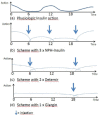Pharmacotherapy of type1 diabetes in children and adolescents: more than insulin?
- PMID: 29796246
- PMCID: PMC5958426
- DOI: 10.1177/2042018818763247
Pharmacotherapy of type1 diabetes in children and adolescents: more than insulin?
Abstract
For paediatric patients with type 1 diabetes, intensified insulin therapy with either multiple daily injection or insulin pump therapy is currently the only method of treatment. To optimize this therapy, insulin analogues are fixed parts of all therapy regimens. New ultra-rapid insulins seem to be beneficial not only in adults but also in this age group. New developments in long-acting analogues have demonstrated safety and will be regular in paediatrics, we hope, soon. Furthermore, the psychosocial approach for consideration of real-life aspects becomes more the focus of therapeutic regimens and is implemented into international guidelines. Technical improvements, such as continuous glucose monitoring, particularly in combination with pump therapy, support the great success of rapid-acting analogues by reducing hypoglycaemias. Non-insulin agents such as SGLT2-inhibitors show beneficial aspects in people with type 1 diabetes. For outpatient care with these currently off-label-used drugs, special training for measurement of ketones should be imperative.
Keywords: insulin therapy; paediatric diabetology; sensor-augmented pump therapy; type 1 diabetes.
Conflict of interest statement
Conflict of interest statement: TB received honoraria and research support from Medtronic, Ypsomed, DexCom travel support Novo Nordisk. OK received honoraria and research support from Abbott, Eli Lilly, Medtronic, Novo Nordisk, and Sanofi, and is a shareholder of DreaMed Ltd. TD received honoraria and research support from Abbott, Bayer, BMS/ AstraZeneca, Boehringer Ingelheim, DexCom, Eli Lilly, Medtronic, Novo Nordisk, Sanofi and Roche, and is a shareholder of DreaMed Ltd.
Figures




References
-
- Wolfsdorf JI, Allgrove J, Craig ME, et al. ISPAD Clinical Practice Consensus Guidelines 2014. Diabetic ketoacidosis and hyperglycemic hyperosmolar state. Pediatr Diabetes 2014; 15(Suppl. 20): 154–179. - PubMed
-
- Biester T, Blaesig S, Remus K, et al. Insulin degludec’s ultra-long pharmacokinetic properties observed in adults are retained in children and adolescents with type 1 diabetes. Pediatr Diabetes 2014; 15: 27–33. - PubMed
-
- Becker RH, Dahmen R, Bergmann K, et al. New insulin glargine 300 Units mL-1 provides a more even activity profile and prolonged glycemic control at steady state compared with insulin glargine 100 Units mL-1. Diabetes Care 2015; 38: 637–643. - PubMed
-
- Byrd RA, Owens RA, Blackbourne JL, et al. Nonclinical pharmacology and toxicology of the first biosimilar insulin glargine drug product (BASAGLAR(®)/ABASAGLAR(®)) approved in the European Union. Regul ToxicolPharmacol 2017; 88: 56–65. - PubMed
Publication types
LinkOut - more resources
Full Text Sources
Other Literature Sources

